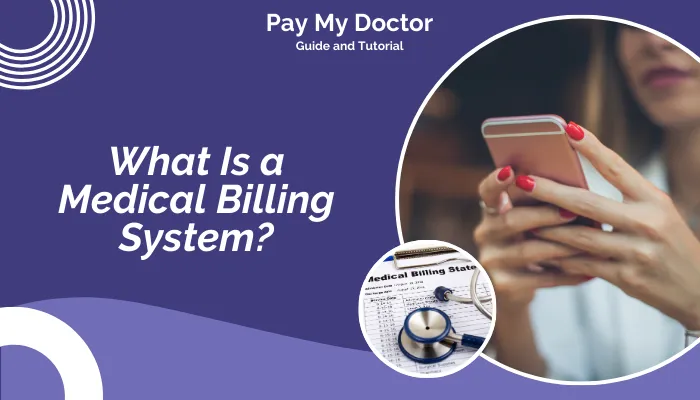What is a Medical Billing System? This is a crucial question for healthcare providers, administrators, and patients alike. The medical billing system refers to the process of submitting and managing claims with health insurance companies to receive payment for services provided by medical professionals.
It’s a vital part of ensuring the financial health of medical practices and hospitals, as well as providing a smooth experience for patients and insurance companies. PayMyDoctor, for instance, offers a platform that simplifies the billing process and improves efficiency for both doctors and patients.
In this blog, we will explore what a medical billing system is, its importance, components, and how it works in today’s healthcare landscape.

Simple Overview of Medical Billing System
So, What is a Medical Billing System? In basic terms, it is the billing process of both patients and the insurance companies through which the healthcare providers receive payments for the respective medical services rendered. This system is crucial as it makes sure the medical practices receive payments for their services while the right payments are being made.
The following are the key elements of a medical billing system:
- Medical Coding: Assigning codes to services rendered.
- Claim Submission: Forwarding claims to the concerned company or authority.
- Payment Posting: Management of payments received from patients and their insurers.
- Accounts Receivable (AR) Management: An online strategy for managing unpaid claims that involves extensive interaction with potential clients.
- Patient Billing: Issuing invoices to patients who owe money for covered services.
This process includes converting a patient’s treatment records into explantations and standard codes which are then claimed, as well as any denials or disputes that are filed or received.
Why Is Medical Billing Important?
What is a medical billing system? It takes care of the business part of the treatment in such a manner, that provides viability to the practice. In the absence of a Medical billing solution, healthcare providers would suffer from underpayments and outstanding bills, rejections from the insurance companies, and chances of billing mistakes thereby resulting in revenue loss.
Automatic medical billing systems improve business liquidity, provide timely management reports and reduce the workload onto the administration and even reduce the bureaucracy within the business structure which makes it possible for the users to concentrate more on the medical side of business and less on the paperwork.
There are numerous reasons as to why medical billing is so important, some of them being:
- Cash Flow Management: Ensures that the healthcare provider gets his due payment for services rendered without delay.
- Accuracy: Contributes in reducing the chance of errors in claims submission, which delays or even prevents approval.
- Compliance: Helps to comply with the legal requirements of the health insurance and their rules, for example: applying ICD-10 codes.
- Improved Patient Experience: No more, more than just consolidation of the patients’ billing interfaces, however, this transforms patients’ experiences and aids them in improved clarity of hospital bills.
Components of a Medical Billing System
Having such a system is beneficial despite its complexity, so the arguments surrounding what is a medical billing system need to be clarified. Below is a breakdown of these components:
1. Patient Information
At the beginning of the process, medical practitioners should gather relevant patient information in as much detail as possible. Such information includes personal data, insurance particulars, as well as medical history. This way, it becomes easier to resolve any issues since the relevant information is readily available.
- Key elements include:
- Name, Address, phone number
- Insurance policy
- Medical history and diagnosis particulars and current ones
2. Medical Coding
This stage is also referred to as the knee deep in all the paperwork aspect of what is a medical billing system. During this phase, it is the duty of the healthcare professionals for the patients diagnosis, any procedures and medical services provided to the patient to be coded by a standard. These codes are the codes submitted to the insurance providers and the term written states it all.
- Common coding systems include:
- ICD-10- International Classification of Diseases 10th Amendment.
- CPT- Current Procedural Codes.
- HCPCS- Healthcare Common Procedural Coding System.
3. Claim Submission
From the presentations made during this phase, once coding has been completed, the medical billing office takes over and scans the claims which are to be forwarded to the relevant insurer. The process is vital because a significant number of claims end up being delayed or fully denied because of inaccuracy at this stage.
- A safe healthcare portal is usually used to submit the claims electronically.
- This portal allows the practitioner to pass paper claims but submissions through the paper are slow, tedious and lagging.
4. Payment Posting
Whenever a patient or an insurance company pays a claim, that payment is recorded into the system. With the help of payment posting, medical practice management software keeps track of what member or group owes money as well as what member or group has been paid off.
- It bears high significance with regard to payment verification and reimbursement of the correct amount.
- Payment posting refers to accounting for all balances and monitoring movements made on these balances.
5. Accounts Receivable Management
Uncollected payments which have been the outstanding dues are referred to accounts receivable (AR). The medical billing system assists the users in management of unpaid claims by sending follow-ups on the claim denials and claims that are overdue for payments.
- Key AR Activities Include:
- This involves following with the denied or rejected claims.
- Reminding Patients with unpaid balances.
- Tracking Claim Payment through the complete cycle.
6. Patient Billing
If patients carry any additional balance when the insurance policy doesn’t cover 100% of the cost of the procedure, they will be charged for that amount. They will receive this as the last invoice. Having patients understand their bills is one of the most important goals as this brings about a good experience for the patient.
- Important components of patient billing:
- Services rendered with reasons for billing.
- Methods of payment and plans available.
- Clarity on the bill avoiding confusions.
Once these components have been understood, one can have a better understanding of how a health care billing system works in streamlining the operations of the providers and the patients.
Benefits of an Efficient Medical Billing System
Having a good systems in place assists the billing partners and the providers in many aspects. Providers are not the only once benefiting from their system, the patients also benefit from it. Here are some of the benefits:
- Faster Payments: This enables quick billing directly after the approval of the Insurance provider which leads to payments being received faster than before.
- Reduction in Errors: The issue of claims being delayed remined as a result of incorrect coding for submission or vice versa has been resolved through accurate submissions of coding with claims.
- Decrease in Opex: Automation of A/R functions such as Process Billing decreases administrative staff and hence, overhead expenses.
- Increase in Net Cash Flow: Proper control measures on accounts receivable guarantees that active invoices are paid allowing the business to have positive resources.
Such instances explain how simply having an up to standard medical billing system in place allows the providers to secure their finances while preventing any hassle for the patients.
Role of Technology in Medical Billing
As medical billing gets more complicated, computerization was certainly a factor in improving efficiency. Most healthcare institutions employ electronic medical billing systems that aid in different aspects of the billing process.
- Advantages of technology in the medical collection services billing:
- Coding and billing using automation: This diminishes human error and encashes the speed of the billing cycle.
- Submission on E-claims: This ensures that claims are submitted in a more efficient and secure manner.
- Reduction of lag time: Able to view the status of a claim as it is being submitted for payment, enabling the provider to follow up on outstanding claims more quickly.
- Electronic Health Record (EHR) linkage: Facilitates the easy exchange of patient details for better coding.
What’s a Medical billing system? It requires balance, structure, and an extravagant amount of patience, but, it’s indispensable in today society and health services.
Conclusion
To wrap up, what is a medical billing system? It is an essential part of the healthcare process that ensures providers are compensated for their services. With the increasing reliance on technology, platforms like PayMyDoctor are revolutionizing the way billing is handled, simplifying the process for both providers and patients.
An efficient medical billing system improves cash flow, reduces errors, and enhances the overall patient experience. Understanding how it works is vital for anyone involved in the healthcare industry, whether you’re a provider, administrator, or patient.
